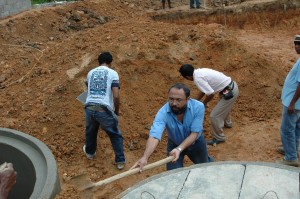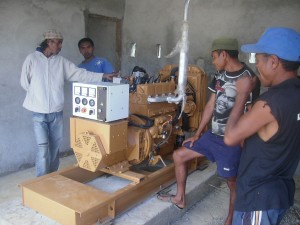Renewable Energies: Timor-Leste invests in Biogas

Although the Rural Electrification Plan is just beginning, the government has already inaugurated around thirty projects related with biogas – two plants of medium capacity, one in Ermera and another in Suai, and around 27 units with small capacity, in sucos from the districts of Liquiça, Bobonaro, Oecusse-Ambeno, Manatuto, Baucau, Viqueque and Los Palos.
“We want to transform the biofuel plants into a urging force of the industries integrated in the rural areas. It is important to clarify that biofuel means more than just energy production. It means a good chance of driving the local economy”, defends the Secretary of State for Energy Policy. It because this type of energy is produced using animal  dung, which allows for the existence of parallel markets for the communities that live in the surroundings of the system. For example, it allows producing food for the animals (grass) that, in return, will supply the dung for bio fuel production”. To give an example: one circuit breaker with a capacity of 142 cubic meters, is supplied by 92 heads of cattle and is at this moment producing 15 quilowatts of electric energy. But the benefit is not limited to the energy production, can become more profitable through reutilization. After the residues are used for the production of biogas, the ones that don’t have gas are processed for the production of organic catalytic. With this we create a production cycle. The biogas not only benefits the communities through the production of alternative energy, but also impels economic grow”, says the Secretary of State Avelino Coelho.
dung, which allows for the existence of parallel markets for the communities that live in the surroundings of the system. For example, it allows producing food for the animals (grass) that, in return, will supply the dung for bio fuel production”. To give an example: one circuit breaker with a capacity of 142 cubic meters, is supplied by 92 heads of cattle and is at this moment producing 15 quilowatts of electric energy. But the benefit is not limited to the energy production, can become more profitable through reutilization. After the residues are used for the production of biogas, the ones that don’t have gas are processed for the production of organic catalytic. With this we create a production cycle. The biogas not only benefits the communities through the production of alternative energy, but also impels economic grow”, says the Secretary of State Avelino Coelho.
The Secretariat of State for Energy Policy has biogas systems with different capacities. For small communities, of two or three families, there are systems of 10 to 20 cubic meters, like the one that was installed in Liquiça, where the  Government is directing the modernization of cooperatives in small communities. For bigger population groups, systems with more that 100 cubic meters are more indicated, as is the case of the system that exists in the Ponilala suco, in Ermera. A biogas system was also installed in the Beco suco, Suai sub-district, that has 84 cubic meters.
Government is directing the modernization of cooperatives in small communities. For bigger population groups, systems with more that 100 cubic meters are more indicated, as is the case of the system that exists in the Ponilala suco, in Ermera. A biogas system was also installed in the Beco suco, Suai sub-district, that has 84 cubic meters.
The biogas also has a positive impact on the environment, since it stimulates and puts in order the animals that nowadays run free, polluting the water and the environment. The Government also predicts that after the veterinary policies to control the slaughter of animals are defined, the biogas system can be an allied to meat production with quality for the national market.










































